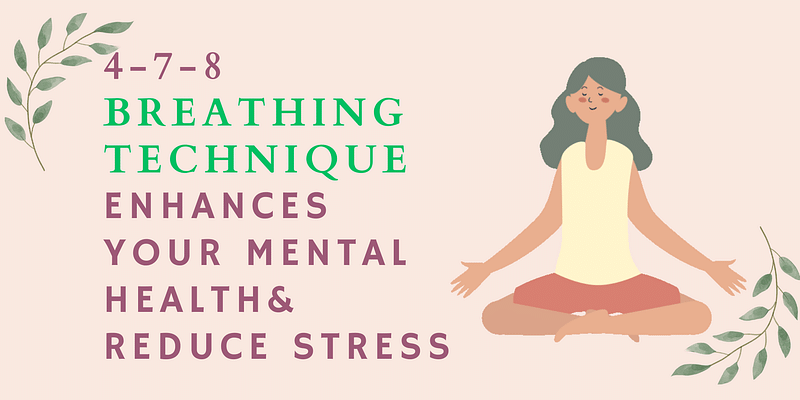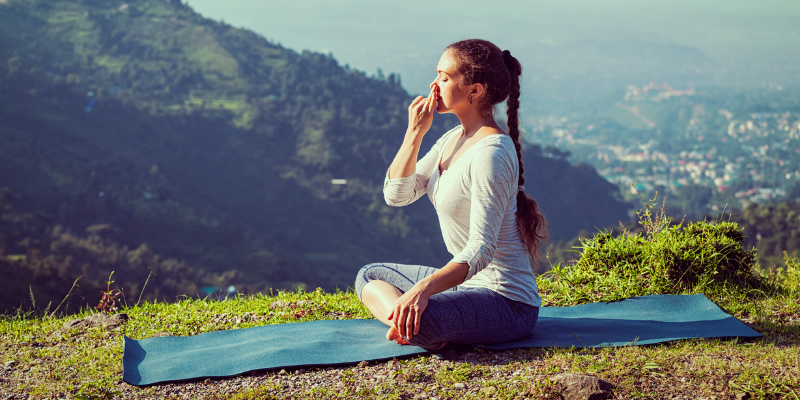
In the fast-paced rhythm of modern life, finding effective and accessible tools and techniques to enhance mental health and manage stress is invaluable. One such technique gaining recognition is the 4-7-8 breathing technique, a simple yet powerful method rooted in the principles of breath regulation. This technique involves a specific pattern of inhalation, breath-holding, and exhalation, with the potential to positively impact mental well-being.
In this article, we will explore how practising 4-7-8 breathing can serve as a valuable resource in reducing stress levels and promoting overall mental health.
What is the 4-7-8 breathing technique?
The 4-7-8 breathing technique consists of a 4-second inhalation, a 7-second breath-hold, and an 8-second exhalation. This method is designed to alleviate anxiety and aid in achieving better sleep. It falls under the category of pranayama, a breath regulation practice frequently employed in yoga. The 4-7-8 breathing technique involves concentrating on long, deep inhalations and exhalations. This rhythmic breathing is integral to various meditation and yoga routines, fostering a sense of calm.
<figure class="image embed" contenteditable="false" data-id="536607" data-url="https://images.yourstory.com/cs/5/80396100-2d6d-11e9-aa97-9329348d4c3e/Yoga_11561037917908.png" data-alt="Breathing Technique " data-caption="
” align=”center”>

Deep, rhythmic breathing offers numerous advantages, such as:
- Easing anxiety
- Facilitating restful sleep
- Controlling cravings
- Diminishing anger responses
How to follow the technique?
Prepare for the 4-7-8 technique by assuming a comfortable seated position and placing the tongue’s tip behind the top front teeth.
Follow this breathing pattern:
- Empty your lungs with a quick exhale.
- Inhale quietly through the nose for 4 seconds.
- Hold the breath for 7 seconds.
- Exhale forcefully through pursed lips, creating a “whoosh” sound for 8 seconds.
- Repeat the cycle up to 4 times.
Given the potential for lightheadedness initially, it’s advisable to perform this technique while seated or lying down to prevent dizziness or falls.
The overall duration of the pattern matters less than preserving the ratio. If holding breath for an extended period is challenging, one can opt for a shorter pattern:
- Inhale through the nose for 2 seconds.
- Hold your breath for 3.5 seconds.
- Exhale through the mouth for 4 seconds.
By maintaining the correct ratio, individuals may experience benefits with consistent 4-7-8 breathing once or twice daily over several days or weeks.
Claims regarding the effectiveness of 4-7-8 breathing, like other techniques, lack extensive clinical research support. Current evidence relies on anecdotal reports from satisfied users.
Is 4-7-8 breathing a type of meditation?
Breathing exercises like 4-7-8 breathing might seem reserved for sacred spaces or pristine meditation studios, but they don’t have to be a formal event.
While 4-7-8 breathing can be part of a meditation routine, it’s technically not a meditation practice itself. Meditation involves cognitive processes of observing and accepting thoughts, whereas breathwork is a way to manipulate the breath.
Although they often complement each other, they aren’t strictly intertwined. It’s not recommended to practice 4-7-8 breathing during activities like driving or working. Instead, it’s about taking a moment in your day to centre yourself, perhaps before an important meeting or conversation.
Benefits of 4-7-8 breathing technique
Here are 10 potential benefits of the 4-7-8 breathing technique:
- Anxiety reduction: Rhythmic breathing can help calm the nervous system, reducing feelings of anxiety.
- Stress management: Practicing 4-7-8 breathing may contribute to better stress management, fostering a sense of relaxation.
- Improved sleep quality: The technique is often used as a natural sleep aid, promoting better sleep quality and duration.
- Enhanced focus and concentration: Regular practice may improve concentration and focus by bringing a sense of mindfulness to the present moment.
- Lowered blood pressure: Deep breathing techniques, including 4-7-8, have been associated with potential reductions in blood pressure.
- Craving control: The method can be a helpful tool for managing and controlling cravings, and supporting individuals in breaking certain habits.
- Mood regulation: Engaging in controlled breathing may positively impact mood, providing a natural and accessible means of emotional regulation.
- Improved respiratory function: Regular deep breathing exercises can enhance respiratory function and lung capacity.
- Anger and irritability reduction: The calming nature of the 4-7-8 technique may contribute to a decrease in anger and irritability.
- Overall well-being: Incorporating this breathing pattern into daily routines can contribute to a general sense of well-being, fostering mental and emotional balance.
It’s important to note that individual responses may vary, and while many people find these benefits, scientific research is ongoing to fully understand the extent of these effects. Always consult with a healthcare professional for personalised advice.







![Read more about the article [Year in Review 2021] Top 10 stories of companies and their ‘Turning Point’](https://blog.digitalsevaa.com/wp-content/uploads/2021/12/feature-04-1639648169326-300x150.png)


